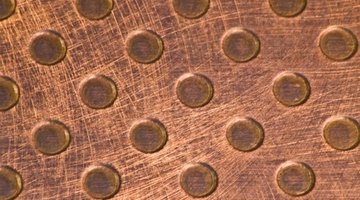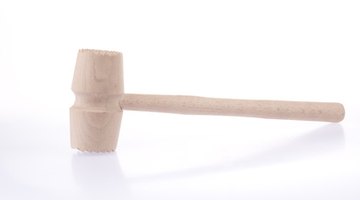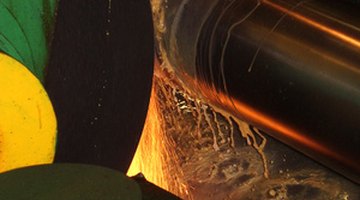With its distinctive, vibrant, brown-orange colour and its soft, malleable nature, copper remains a popular choice for metalwork, arts and crafts projects.
Unlike gold or silver, copper is an affordable metal. With the right tools, it is easy to assemble a coppersmithing shop and create practical and artistic works for hobby or retail purposes.
Anvil, Bench and Sandbag

The anvil, work bench and sandbag are the foundations of the coppersmith's shop.
Metalworking benches must be sturdily constructed of wood.
The bench must support the weight of the coppersmithing tools, the anvil and various pieces and sheets of metal. It may also have drawers or compartments for tool storage.
Coppersmith anvils are typically square shaped, and measure an average of 7 inches in width. Typically, these anvils are built with a vice grip to help the smith secure his metalwork.
- The anvil, work bench and sandbag are the foundations of the coppersmith's shop.
- Typically, these anvils are built with a vice grip to help the smith secure his metalwork.
Though square, coppersmith anvils may have one or more rounded edges. In his book, "The Practical Metal-Worker's Assistant," Oliver Byrne notes that "others have rounded faces... a few assume the form of a rounded ridge... and many have bulbs or buttons, as if turned in the lathe."
A series of smaller anvils, known as stakes, supplement the main anvil. They are smaller in size--some 1/2-inch long. These miniature anvils are helpful for finer, more detailed copper work.
Sandbags enable coppersmiths to mould sheet copper into more delicate, flowing shapes. Typically made of durable leather, the sandbag is often used to form the base of copper bowls or other rounded containers.
Bending, Cutting and Hammering Tools

Copper can be cut, bent and hammered into a variety of shapes.
To cut copper, smiths use hand shears, also called snips, for smaller jobs.
Projects that require heavier or thicker metal use bench shears. Bench shears have a specially shaped lower handle, with an extension that is placed in the work bench's square hole, for additional support.
More intricate cutting may be done with a jeweller's saw, also known as a coping saw. Its thin, inflexible blades make fine, more precise cuts.
Bending copper requires a hatchet stake, a long, flat piece of cast iron with which the smith makes sharp, clean corners. To create rounded shapes, such as copper pipe, a forming machine, or bending block, is used in conjunction with a mandrel. This metal bar, usually tapered and rounded, helps shape copper into smooth curves.
Coppersmiths have different hammers to achieve varied effects. To create decorative or artistic metal work, a coppersmith may use a sharp-edged hammer, a ball-peen hammer and various wooden mallets.
The sharp-edged hammer looks similar to a pickaxe. Its tapered, pointed end helps form deep patterns and impressions into the metal.
Ball-peen hammers have a small, rounded edge, and are used for less delicate hammering needs.
These hammers typically imbue the copper surface with a texture. Skilled coppersmiths can manipulate the ball-peen hammer to create stunning textural effects.
The planishing hammer looks similar to the ball-peen. Its rounded surfaces are highly polished. Planishing is a process of hammering out defects and dents in sheet metal to produce a smooth, flowing surface.
Mallets can be made of wood, rubber or nylon.
- Copper can be cut, bent and hammered into a variety of shapes.
- To create rounded shapes, such as copper pipe, a forming machine, or bending block, is used in conjunction with a mandrel.
- Mallets can be made of wood, rubber or nylon.
Forming mallets are usually wooden. Their purpose is to begin the metal shaping process. They lay the groundwork for more precise work by the sharp-edge, ball-peen or planishing hammer.
Buffers, Polishers and Smoothers

Buffing wheels give copper work its final brilliant lustre.
These wheels are usually coated with soft cloth or with wire brushes.
Buffing wheels are commonly motor-driven at high speeds. Caution should be taken with their use. Wear safety glasses and other protective devices. While this part of the process can hone copper work to sparkling beauty, it can also send slivers of metal flying toward the user.
Motor-driven buffing wheels offer a more uniform polished surface. They are essential to coppersmiths who produce items in volume. Hand polishing is time consuming and can appear uneven in comparison.
Coppersmiths of today use essentially the same tools as their 18th-century counterparts. With the right tools, and some experience, coppersmithing can be a satisfying hobby or occupation.
- Buffing wheels give copper work its final brilliant lustre.
- With the right tools, and some experience, coppersmithing can be a satisfying hobby or occupation.
